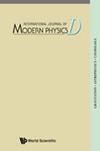The semiclassical limit of quantum gravity and the problem of time
IF 2.1
4区 物理与天体物理
Q3 ASTRONOMY & ASTROPHYSICS
引用次数: 0
Abstract
The question about the appearance of time in the semiclassical limit of quantum gravity continues to be discussed in the literature. It is believed that a temporal Schrodinger equation for matter fields on the background of a classical gravitational field must be true. To obtain this equation, the Born - Oppenheimer approximation for gravity is used. However, the origin of time in this equation is different in works of various authors. For example, in the papers of Kiefer and his collaborators, time is a parameter along a classical trajectory of gravitational field; in the works of Montani and his collaborators the origin of time is introducing the Kuchar - Torre reference fluid; in the extended phase space approach the origin of time is the consequence of existing of the observer in a fixed reference frame. We discuss and compare these approaches. To make the calculations transparent, we illustrate them with a model of a closed isotropic universe. In each approach, one obtains some Schrodinger equation for matter fields with quantum gravitational corrections, but the form of the equation and the corrections depend on additional assumptions which are rather arbitrary. None of the approaches can explain how time had appeared in the Early Universe, since it is supposed that classical gravity and, therefore, classical spacetime had already come into being.量子引力的半经典极限和时间问题
关于时间在量子引力的半经典极限中出现的问题在文献中继续讨论。人们认为,在经典引力场的背景下,物质场的时间薛定谔方程一定是真的。为了得到这个方程,使用了重力的玻恩-奥本海默近似。然而,在不同作者的作品中,这个方程中的时间起源是不同的。例如,在Kiefer及其合作者的论文中,时间是引力场经典轨迹上的一个参数;在蒙塔尼及其合作者的作品中,时间的起源是引入库查尔-托雷参考流体;在扩展相空间方法中,时间的起源是观测者在固定参考系中存在的结果。我们讨论并比较这些方法。为了使计算透明,我们用一个闭合各向同性宇宙的模型来说明它们。在每种方法中,人们都会得到一些具有量子引力修正的物质场薛定谔方程,但方程的形式和修正取决于额外的假设,这些假设是相当武断的。这些方法都无法解释时间是如何在早期宇宙中出现的,因为人们认为经典引力和经典时空已经形成。
本文章由计算机程序翻译,如有差异,请以英文原文为准。
求助全文
约1分钟内获得全文
求助全文
来源期刊

International Journal of Modern Physics D
地学天文-天文与天体物理
CiteScore
3.80
自引率
9.10%
发文量
181
审稿时长
4-8 weeks
期刊介绍:
Gravitation, astrophysics and cosmology are exciting and rapidly advancing fields of research. This journal aims to accommodate and promote this expansion of information and ideas and it features research papers and reviews on theoretical, observational and experimental findings in these fields. Among the topics covered are general relativity, quantum gravity, gravitational experiments, quantum cosmology, observational cosmology, particle cosmology, large scale structure, high energy astrophysics, compact objects, cosmic particles and radiation.
 求助内容:
求助内容: 应助结果提醒方式:
应助结果提醒方式:


